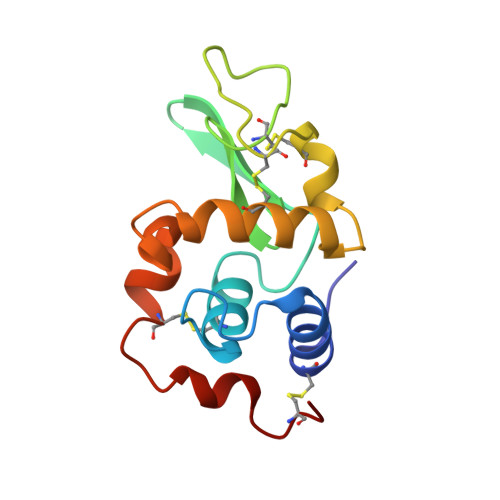Thermal stability determinants of chicken egg-white lysozyme core mutants: hydrophobicity, packing volume, and conserved buried water molecules.
Shih, P., Holland, D.R., Kirsch, J.F.(1995) Protein Sci 4: 2050-2062
- PubMed: 8535241
- DOI: https://doi.org/10.1002/pro.5560041010
- Primary Citation of Related Structures:
1LSM, 1LSN - PubMed Abstract:
A series of 24 mutants was made in the buried core of chicken lysozyme at positions 40, 55, and 91. The midpoint temperature of thermal denaturation transition (Tm) values of these core constructs range from 60.9 to 77.3 degrees C, extending an earlier, more limited investigation on thermostability. The Tm values of variants containing conservative replacements for the wild type (WT) (Thr 40-Ile 55-Ser 91) triplet are linearly correlated with hydrophobicity (r = 0.81) and, to a lesser degree, with combined side-chain volume (r = 0.75). The X-ray structures of the S91A (1.9 A) and I55L/S91T/D101S (1.7 A) mutants are presented. The former amino acid change is found in duck and mammalian lysozymes, and the latter contains the most thermostable core triplet. A network of four conserved, buried water molecules is associated with the core. It is postulated that these water molecules significantly influence the mutational tolerance at the individual triplet positions. The pH dependence of Tm for the S91D mutant was compared with that of WT enzyme. The pKa of S91D is 1.2 units higher in the native than in the denatured state, corresponding to delta delta G298 = 1.7 kcal/mol. This is a low value for charge burial and likely reflects the moderating influence of the buried water molecules or a conformational change. Thermal and chemical denaturation and far UV CD spectroscopy were used to characterize the in vitro properties of I55T. This variant, which buries a hydroxyl group, has similar properties to those of the human amyloidogenic variant I56T.
- Department of Chemistry, University of California, Berkeley 94720, USA.
Organizational Affiliation:
















